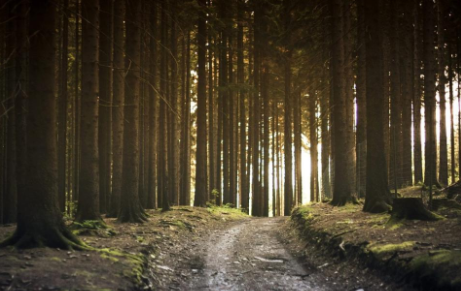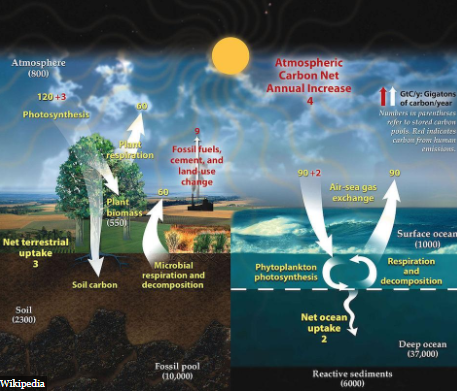
In a string of late research, examines have discovered earth might be the concealed key to an atmosphere arrangement. It's not the most glitzy of themes for a great many people, yet soils the world over both can catch and discharge carbon enough to essentially hose the impacts of environmental change.
There are two huge investigations that as of late discovered soils help moderate carbon outflows in the climate and discharge carbon amid times of aggravations. In any case, to start with, how about we talk about how carbon gets into our dirts, where we discover it today, and what controls how it is kept and put away in soils.
How Is Carbon Trapped In Our Soils?
Every single living thing contain carbon and woodlands can splash up huge measures of carbon from the air through photosynthesis. They take in carbon dioxide and discharge oxygen, as you've likely heard some time recently. In any case, as with numerous things on Earth, there are components to discharge that carbon dioxide once again into the climate and adjust the carbon cycle. This component is bacterial breath, biodegradation, disintegration, spoiling, every single comparable word for a similar procedure.
This component is bacterial breath, biodegradation, disintegration, decaying, every single comparative word for a similar procedure. The procedure to discharge carbon from trees once more into the environment as carbon dioxide is breath, the inverse of photosynthesis. While people breathe, microscopic organisms are significantly more productive and significantly less fussy about what they eat. For example, when a tree passes on in the woodland it quits removing carbon dioxide from the climate and consolidating it into itself. By then, microscopic organisms start to separate the tree and in the process breathing or discharging carbon dioxide.
In any case, microbes aren't impeccable at separating everything and a specific measure of carbon stays in dead plant or creature matter in the dirts. This carbon that microorganisms were never ready to get to is an imperative piece of our day by day lives. The carbon could in the end transform into hydrocarbons (oil/gas/coal) and it goes about as a sink to lessen the measure of carbon in the air for drawn out stretches of time.

People discharge around 10 billion metric huge amounts of carbon into the environment consistently. However, 3,500 billion metric huge amounts of carbon lies in our dirts. This implies soils have both the capacity to take in a great deal of the carbon we transmit yet additionally discharge a lot of carbon into the climate.
Destabilizing Carbon In Soils
So what destabilizes this procedure? What makes soils take up and store more carbon and discharge more carbon?
Reduction carbon in soils
To start with, how about we handle components that reason soils to discharge carbon. One major one, as you may have heard, is softening of permafrost in northern landmasses. The procedure is straightforward, while the ground is solidified it's excessively cool for microorganisms, making it impossible to separate the carbon in soils and along these lines it essentially stays there unaltered. Be that as it may, when permafrost liquefies, out of the blue it's sufficiently warm for microbes to begin eating the plant material and discharging carbon dioxide once more into the climate.
Another enormous factor in how soils discharge carbon is an aggravation to soils. When carbon gets to a specific profundity, there's no oxygen in the dirt any longer for the microbes to separate the carbon. In this way the carbon just stays there and gets covered further and more profound. In any case, in the event that somebody stops by and furrows the earth or expels trees out of the blue that dirt is blended with oxygen and microorganisms would now be able to get to the carbon to breathe and discharge carbon dioxide.
Both of these procedures of discharging carbon into the climate are expanding as people keep on warming the planet and change regular zones.
Increment carbon in soils
Be that as it may, what are the ways carbon stockpiling in soils can increment? One evident route is to diminish modifying common ranges, make more ensured old development backwoods, restrict deforestation, and so forth. Be that as it may, these arrangements are hard for people to actualize as people are vastly improved at starting activity when contrasted with ceasing an activity.
One thing people can do to build carbon admission into soils is to treat, something we as of now do all the time. This gives plants the capacity to develop and take up carbon substantially speedier and along these lines overpower microbes and increment carbon stockpiling in soils. Shockingly, compost has an entire host of different issues.
Some other great approaches to expand carbon stockpiling in soils is to lessen culturing, compost, plant lasting yields, and hold plants that decrease disintegration of soils. These are fundamentally methods for influencing a modified domain to act and carry on more normally. In this way, tragically, there aren't incredible routes for people to design courses for carbon to be put away in soils past leaving regular habitats to do their thing. In any case, when left in its common state, soils can retain noteworthy measures of the carbon dioxide we discharge into the environment yearly.
What is imperative is the more regular habitats are kept up, the more soils will go about as a support to diminish the carbon dioxide people emanate into the environment. All things considered, the Earth is great at settling itself after worldwide disturbances. Worldwide volcanic ejections, separating of a supercontinent, mass eradication causing shooting stars, and now an extraordinary rate of warming and carbon dioxide discharge. Tragically for people, we're in the interest of personal entertainment on Earth's next time of adjustment.
Congratulations @ahmedmukhtar! You have completed some achievement on Steemit and have been rewarded with new badge(s) :
Click on any badge to view your own Board of Honor on SteemitBoard.
For more information about SteemitBoard, click here
If you no longer want to receive notifications, reply to this comment with the word
STOP